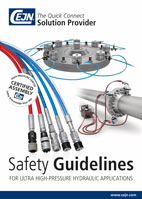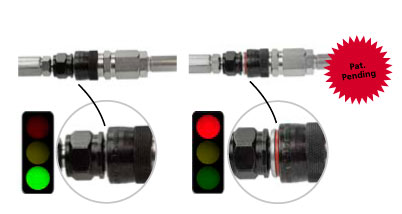 Handling high-pressure hydraulics is serious business. It often involves working in confined spaces, lifting heavy machine parts or dealing with weather extremes in remote locations. This has led to a demand for smaller and lighter tools to simplify tasks. But that necessitates higher pressure to generate sufficient force or torque.
Handling high-pressure hydraulics is serious business. It often involves working in confined spaces, lifting heavy machine parts or dealing with weather extremes in remote locations. This has led to a demand for smaller and lighter tools to simplify tasks. But that necessitates higher pressure to generate sufficient force or torque.
To make engineers and maintenance personnel better aware of the issues surrounding high-pressure systems, quick-connect coupling manufacturer CEJN, Gurnee, Ill., recently published a white paper, “Safety Guidelines for Ultra High-Pressure Hydraulic Applications.” It offers safety advice and practical tips for working with high-pressure hydraulic tools. Here are a few examples.
Respect pressure
CEJN engineers stress that extreme pressure demands a high level of safety, as a leak or accidental disconnection could be catastrophic. Hose assemblies may fail abruptly and unexpectedly for any number of reasons, and oil shooting out at high pressure and velocity can cause serious personal injury and severe damage to equipment and products. Resulting environmental pollution can also demand costly cleanup.
Potential hazards include burst hose, whipping hose ends, oil-spray leakage, and coupling blow-off. It is critical to shut down machinery immediately if a leak occurs. And never, ever, try to locate the leak with your hands, or any other part of the body when a hose set is pressurized. Instead, use a suitable implement to inspect for hose damage.
And if a fluid-injection injury occurs, treat it as a medical emergency and seek immediate treatment.
Don’t mix quick-connect couplings
Don’t mix quick-connect coupling halves from different manufacturers. And do not mix genuine products from a reputable manufacturer with so-called interchangeable parts from other suppliers. Unfortunately, this is especially important today when copycat couplings and hoses are circulating on the market.
The interface between coupling and nipple is crucial. The unique tolerances and dimensions engineered into high-quality parts are compromised by mixing brands. And even if the connection seems to fit, this does not mean that the connector will work optimally and safely. In the worst case, it could lead to accidental disconnection and high-pressure oil spray.
CEJN connectors, for example, require close control of material hardness, maintain critical dimensions and tolerances to ensure leak-free performance, and use high-quality locking balls and a metal-to-metal seal for maximum safety.
Connecting components from different manufacturers not only leads to severe safety hazards, it also invalidates the warranty and may open the door to costly litigation in the case of a failure.

CEJN Alert-Ring System
Making a safe connection is also essential to avoid accidental disconnection. If you’re not certain that a coupling is correctly and robustly connected, disconnect it and start over. One way to eliminate the guesswork is to use the CEJN Alert-Ring System. Since 2014, CEJN high-pressure quick-connect couplings have a red “alert ring” installed on the female coupling half that simply and clearly indicates whether or not the connection is safe. If, upon connection, the locking sleeve fully covers the red ring so it is not visible, the connection is safe. However, if the ring remains visible, the connection is not complete and must be redone. Otherwise, pressurizing the system could cause the nipple to shoot out of the coupling.
Inspection and maintenance
In addition to ensuring that the design and operation of tools and machines comply with safety regulations, make sure to inspect hose assemblies for damage and wear at regular intervals—before every use if possible.
Hose assemblies are subject to wear and aging. In addition to normal wear, hose can get squeezed, kinked, flattened, abraded and otherwise damaged. Regular inspection and maintenance—by qualified technicians—ensures safe operation over the life of the assembly. Inspect hose sets when not pressurized and immediately replace a defective or damaged hose assembly.
On quick-connect couplings, always check for excessive wear on the nipple. If a coupling is difficult to connect/disconnect, change the nipple before it damages the coupling. Also ensure the coupling is free of corrosion, and threads and sealing surfaces are clean and undamaged. As with hose, couplings that show wear or damage must be replaced immediately.
CEJN also recommends that users pressure-test hose assemblies at two-year intervals (at 1.5× working pressure) and totally replace assemblies every six years. Change out hose assemblies and quick-connect systems at the same time.
CEJN’s ultra high-pressure quick connect couplings and hoses are routinely used on jacks, cable cutters, pipe bending and bolt tensioning tools, torque wrenches, rescue equipment and hydrostatic-testing equipment. Proper selection, installation and maintenance practices help ensure safe operation and long, productive life.
CEJN
www.cejn.us

Leave a Reply